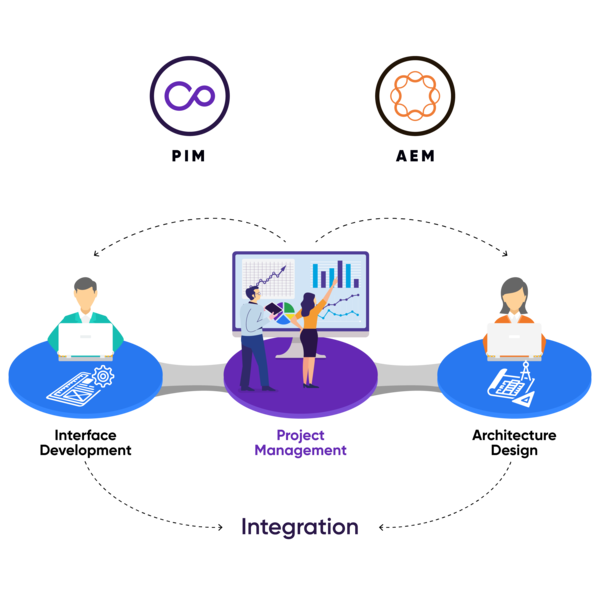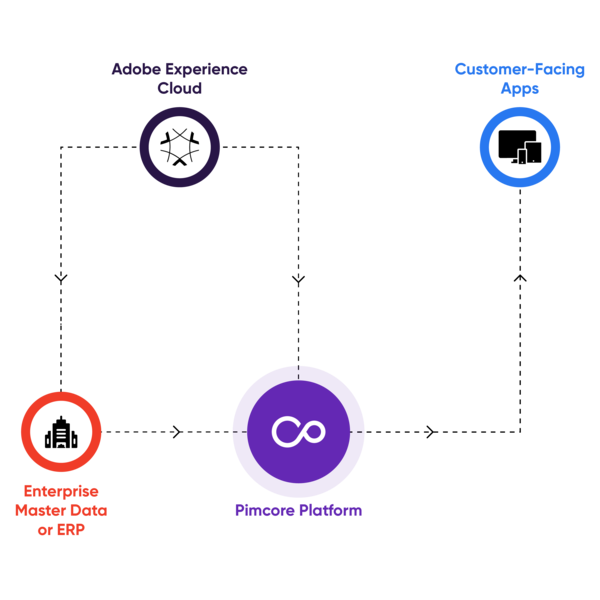PIM Integration with Adobe Experience Manager (AEM)
Management of product data and digital assets consumes decent effort and budget of organizations. That’s where a dedicated data management (products and assets) solution comes into play— minimizing the headache of marketing operations, content management, analytics, and omni-channel experience management. It enables you not just to improve operational efficiency, speed-to-market, and better performance but also infuse excellence in overall customer experience. Have a look how internal teams can benefit from product experience management, too!
What You’ll Learn From This Insight:
I. Quick Facts about PIM and AEM
- What is Product Information Management (PIM)?
- What is Adobe Experience Manager (AEM)?
- Why Integrate PIM with AEM?
II. How PIM and AEM Integration Makes Your Life Easier
III. The PIM AEM Integration Approach
IV. Benefits of PIM Software for Businesses
Quick Facts about PIM and AEM
What is Product Information Management (PIM)?
A PIM Software centralizes all your marketing, sales, and technical product information. With PIM application, you can manage, organize, and maintain an approved shareable version of rich product content. It can be integrated with existing applications and IT systems too. Moreover, a PIM helps improve data quality and availability for effective execution and engagement across multiple touchpoints.
What is Adobe Experience Manager (AEM)?
Adobe Experience Manager (AEM) provides a comprehensive solution for content and digital asset management needs for building websites, mobile apps, and more.
Why Integrate PIM with AEM?
Adobe Experience Manager (AEM) provides a comprehensive solution for content and digital asset management needs for building websites, mobile apps, and more.
The integration of PIM software with Adobe Experience Manager can solve many problems for enterprises. First, a robust PIM solution can handle complex product data of any type coming from an enterprise data source ( such as ERP or enterprise master data). Second, with an integrated solution, organizations can maximize the value of both their product data ( descriptions, metadata, and other related information) and digital assets ( image, video, gif, and rich media) to bring agility, speed, and creativity in marketing and sales teams’ day-to-day activities.

How PIM and AEM Integration Makes Your Life Easier?
PIM software acts as a central solution that pulls your ERP data, combines product data with digital assets or media files managed in Adobe Experience Manager (AEM), and then pushes to the CMS/eCommerce platform, or other customer-facing applications.
It enables you to build a descriptive product data, create marketing copy in a centralized and streamlined way, and publish it across channels in real-time by ensuring consistency and accuracy in all product-related communication that your customers see.
The integrated solution can help you in many ways, including:
- Foster creativity and innovation in marketing campaigns.
- Build greater flexibility, agility, and continuity in all marketing operations.
- Improve collaboration amongst teams and reduce manual errors.
- Accelerate time-to-market for a competitive edge.
- Provide engaging customer experience and deliver detailed product values to end-consumers.
- Save time and money on managing product data and digital assets.

The PIM AEM Integration Approach
PIM software's API driven approach enables fast and seamless connection to Adobe Experience Manager, and third-party software such as ERP, CRM, and BI. In fact, it allows integration with IT infrastructure and makes it easily extendable.
Product information management software provides a solid foundation with generic functionality for all kinds of web applications and therefore allows rapid application development and building customer solutions—fast and economical.
Benefits of PIM Software for Businesses
Connect Pimcore PIM with Anything
Pimcore's open source PIM software centralizes and harmonizes all your marketing, sales and technical product information. Pimcore's "connect anything" architecture and its holistic API driven approach enable an unimaginable manner of connectivity with business enterprise systems (ERP, CRM, BI, ESB,...) or external 3rd party applications. Either use the native PHP API or the full-featured REST Webservice API for two-way real-time communication with other systems.
- Adaptable: Easy to use with a GUI to speed-up the learning curve.
- Cloud Compatible: A cloud, on-premises, and hybrid capabilities to simplify the integration
- Open source: Provide more flexibility without vendor lock-in and license fee
- Many connectors: With pre-built connectors, you can save time and effort.
Pimcore and Adobe Experience Manager Use Case
Centralization of Multiple Countries’ Scattered Data
A world’s largest producer of clay blocks centralizes multiple countries’ scattered data by integrating Pimcore with Adobe Experience Manager and SAP. The client had scattered product data from multiple countries and plants, and there was no standard way to refer to the same products. There was also huge complexity in viewing and managing data of two different systems, i.e., ERP and database systems (i.e. SAP R3 and PDB) for a single Stock Keeping Unit (SKU). An intelligent system was created using the Pimcore platform. Pimcore was chosen because of its capability to provide a single platform solution with system generated hierarchy and stored SKU data in an organized way with multiple language support.
All the same product SKUs clubbed under a unique system generated identified – GPI (Global Product Identifier). Pimcore is integrated with Adobe Experience Manager and SAP system to connect product data (having complex data modeling) with enterprise data and digital assets. Also, complex SAP R3 and PDB data are integrated with the Pimcore based system.
The centralized system has now made easy to manage all product groups SKU data with sales and marketing information in one place. The solution has also eliminated technical expertise required for managing different systems, allowing users to increase control and flexibility for their product groups.